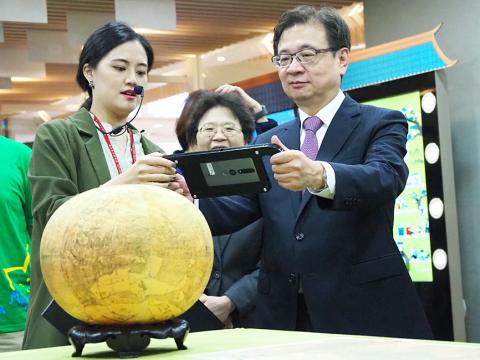Taipei Medical University (TMU) is featuring digitized artworks from the National Palace Museum in an exhibition where visitors use augmented reality (AR) and virtual reality (VR) facilities to appreciate national treasures such as the Shueishalian Trail (水沙連古道) or study patterns on ancient bronze vessels.
The National Palace Museum Pop-Up Exhibition, held on the first floor of the university’s Xing-Chun Building, runs until Wednesday next week, the university said in a news release yesterday.
In addition to AR and VR, the exhibition showcases cloud learning and interactive teaching, allowing visitors to immerse themselves in virtual surroundings that incorporate scenes from museum paintings, it said.

Photo courtesy of the Taipei Medical University
The digital technology allows visitors to appreciate the art in a different way, it said, adding that people can examine the structure and patterns of ancient bronze vessels used for wine storage with a proximity that would have not otherwise been possible.
Over the past few years, the university has been promoting the use of digital technologies such as AR and VR for creative pedagogy, hoping to encourage students to embark on independent study remotely to enhance their interdisciplinary knowledge, university president Lin Chien-huang (林建煌) said.
Interactive games and do-it-yourself experiences offered in the exhibition can spark the imagination and creativity of the students and faculty, and bring more of the arts and humanities into the university, Lin said.
Since the university signed a memorandum of understanding with the museum in April last year, several university courses have been taught on the museum grounds, it said, adding that some students have become familiar enough with the museum to give tours to university faculty and international students.
The university’s Center for Arts and Humanities, which earlier this year received a subsidy from the museum, has launched a pilot project that is developing community healthcare lesson plans that combine museum resources with medical expertise, and that takes groups of senior citizens on tours of the museum, it said.

An essay competition jointly organized by a local writing society and a publisher affiliated with the Chinese Communist Party (CCP) might have contravened the Act Governing Relations Between the People of the Taiwan Area and the Mainland Area (臺灣地區與大陸地區人民關係條例), the Mainland Affairs Council (MAC) said on Thursday. “In this case, the partner organization is clearly an agency under the CCP’s Fujian Provincial Committee,” MAC Deputy Minister and spokesperson Liang Wen-chieh (梁文傑) said at a news briefing in Taipei. “It also involves bringing Taiwanese students to China with all-expenses-paid arrangements to attend award ceremonies and camps,” Liang said. Those two “characteristics” are typically sufficient

A magnitude 5.9 earthquake that struck about 33km off the coast of Hualien City was the "main shock" in a series of quakes in the area, with aftershocks expected over the next three days, the Central Weather Administration (CWA) said yesterday. Prior to the magnitude 5.9 quake shaking most of Taiwan at 6:53pm yesterday, six other earthquakes stronger than a magnitude of 4, starting with a magnitude 5.5 quake at 6:09pm, occurred in the area. CWA Seismological Center Director Wu Chien-fu (吳健富) confirmed that the quakes were all part of the same series and that the magnitude 5.5 temblor was

The brilliant blue waters, thick foliage and bucolic atmosphere on this seemingly idyllic archipelago deep in the Pacific Ocean belie the key role it now plays in a titanic geopolitical struggle. Palau is again on the front line as China, and the US and its allies prepare their forces in an intensifying contest for control over the Asia-Pacific region. The democratic nation of just 17,000 people hosts US-controlled airstrips and soon-to-be-completed radar installations that the US military describes as “critical” to monitoring vast swathes of water and airspace. It is also a key piece of the second island chain, a string of

The Central Weather Administration has issued a heat alert for southeastern Taiwan, warning of temperatures as high as 36°C today, while alerting some coastal areas of strong winds later in the day. Kaohsiung’s Neimen District (內門) and Pingtung County’s Neipu Township (內埔) are under an orange heat alert, which warns of temperatures as high as 36°C for three consecutive days, the CWA said, citing southwest winds. The heat would also extend to Tainan’s Nansi (楠西) and Yujing (玉井) districts, as well as Pingtung’s Gaoshu (高樹), Yanpu (鹽埔) and Majia (瑪家) townships, it said, forecasting highs of up to 36°C in those areas